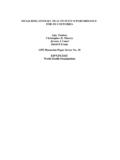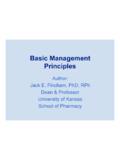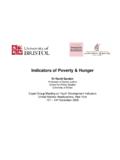Transcription of School Performance - ed
1 School Performance ART CULOS DE REVISI N Prop sitos y Representaciones Ene. Jun. 2015, Vol. 3, N 1: pp. 313-386. ISSN 2307-7999 e-ISSN 2310-4635 Sobre el rendimiento escolar Received: 01-12-14 Approved: 30-04-15 H ctor A. Lamas1a 1 Academia Peruana de Psicolog a, Lima, Per . aDoctor Psychology. Universidad San Ignacio de Loyola, Vicerrectorado de Investigaci n y Desarrollo, 2015. Este art culo se distribuye bajo licencia CC BY-NC-ND Internacional ( ). Correspondencia Email: Notas Tribute and recognition to Dra. Violeta Tapia Mendieta. Citar Como: Lamas, H. (2015). School Performance . Prop sitos y Re-presentaciones, 3(1), 313-386. doi: 352 School PerformanceProp sitos y Representaciones. Vol. 3, N 1 SummaryThe School Performance study of students is, due to its relevance and complexity, one of the issues of major controversy in the educational research, and it has been given special attention in the last decades.
2 This study is intended to show a conceptual approach to the School Performance construct, contextualizing the reality in the regular basic education classrooms. The construct of learning approaches is presented as one of the factors that influences the School Performance of students. Besides, an outlook of the empirical research works related to variables that are presented as relevant when explaining the reason for a specific Performance in students is shown. Finally, some models and techniques allowing an appropriate study of School Performance are : School Performance , factors, indicators, estudio del rendimiento acad mico de los estudiantes es, por su relevancia y complejidad, uno de los temas de mayor controversia en la investigaci n educativa, y se le ha dedicado especial atenci n en las ltimas d cadas.
3 En este art culo se trata de presentar una aproximaci n conceptual al constructo del rendimiento escolar, contextualiz ndolo con la realidad que acontece en las aulas de la educaci n b sica regular. Se presenta el constructo de los enfoques de aprendizaje como uno de los factores que incide en el rendimiento escolar de los estudiantes. Asimismo, se presenta un panorama resumido de investigaciones emp ricas relacionadas con variables que se han presentado como relevantes a la hora de explicar el porqu de un determinado rendimiento en los estudiantes. Tambi n se trata sobre la evaluaci n del rendimiento escolar y las variables que lo acercan a tener una mayor objetividad. Por ltimo, se presentan algunos modelos y t cnicas que han permitido un adecuado estudio del rendimiento clave: Rendimiento acad mico, factores, indicadores, evaluaci San Ignacio de LoyolaH ctor A.
4 LAmAsIntroductionSchool Performance is an issue that deeply concerns students, parents, teachers and authorities not only in our country, but also in many other Latin American countries and complexity of the academic Performance starts from its conceptualization. Sometimes it is known as School readiness, academic achievement and School Performance , but generally the difference in concepts are only explained by semantics as they are used as synonyms. Conventionally, it has been agreed that academic Performance should be used in university populations and School Performance in regular and alternative basic education populations. We will point out just a few because there is a diversity of authors agree that academic Performance is the result of learning, prompted by the teaching activity by the teacher and produced by the student.
5 From a humanistic approach, Martinez (2007) states that academic Performance is the product given by the students and it is usually expressed through School grades (p. 34). Fifteen years ago, Pizarro (1985) referred to academic Performance as a measure of the indicative and responsive abilities that express, in an estimated way, what a person has learned as a result of a process of education or Caballero et al. (2007), academic Performance involves meeting goals, achievements and objectives set in the program or course that a student attends. These are expressed through grades which are the result of an assessment that involves passing or not certain tests, subjects or courses. On their part, Torres and Rodr guez (2006 quoted by Willcox, 2011) define academic Performance as the level of knowledge shown in an area or subject compared to the norm, and it is generally measured using the grade point PerformanceProp sitos y Representaciones.
6 Vol. 3, N 1 The purpose of the School or academic Performance is to achieve an educational goal, learning. In this regard there are several components of the complex unit called Performance . They are learning processes promoted by the School that involve the transformation of a given state, into a new state, and they are achieved with the integrity in a different unit with cognitive and structural elements. Performance varies according to circumstances, organic and environmental conditions that determine skills and academic Performance involves factors such as the intellectual level, personality, motivation, skills, interests, study habits, self-esteem or the teacher-student relationship. When a gap between the academic Performance and the student s expected Performance occurs, it refers to a diverging Performance .
7 An unsatisfactory academic Performance is the one that is below the expected Performance . Sometimes it can be related to teaching methods. (Marti, 2003, p. 376).To the present, the expansion of educational opportunities in Latin America has not helped to compensate for the inequalities of a socioeconomic and cultural background. Although it is true, today millions of children and young people, previously excluded from education, enter the educational process K-12 (which term includes preschool, primary and secondary education), on average of one half does not complete it, and the other half continues highly dissimilar paths from the point of view of educational quality. In fact, among those who complete secondary education - a condition to avoid the risk of falling below the poverty line in Latin America - at age 15 an average of 50% have failed to achieve a minimum proficiency in learning skills defined by the PISA assessment (Brunner, 2013).
8 The Organization for Economic Cooperation and Development (OECD) has published the results of the international PISA 2012 with the participation of Peru among other 65 countries or territories. 355 Universidad San Ignacio de LoyolaH ctor A. LAmAsPISA (acronym for Program for International Student Assessment) is held every three years. It tests 15-year-old s competencies in mathematics, reading and science. PISA 2012 focused on mathematics, that is, the assessment presented more questions in this area, along with Reading and Science questions. In Peru, a nationally representative sample was assessed. This sample included 6035 15-year-old students, from 240 secondary schools or similar institutions in all regions of the country. Public, private, urban and rural institutions were included. While it is true that international comparisons make a significant contribution to the debate on quality of education, they should not be considered only as the final study on educational accomplishments.
9 The results achieved by Peru in PISA 2012 in Mathematics are low. Peru s average score was 368 points. According to Performance levels, PISA places students in 6 levels. On average, the assessed Peruvian students are located at Level 1, although a significant percentage (47%) is below level 1. In Science, the situation of Peruvian students is similar to that in mathematics. A score of 373 was obtained and, on average, students are also at Level 1 (Peruvian Ministry of Education (MINEDU) - Measurement Unit of Educational Quality (UMC), 2012). Regarding reading competencies, while our students showed low results in PISA 2012 compared to other Latin American countries participating in PISA, an steadily progress over the last 11 years is reported in this area. Between 2001 and 2012 the Peruvian average has increased from 327 to 384 points.
10 In the previous cycle, PISA 2009, we have increased in 14 points which is the highest progress among Latin American countries participating in PISA (MINEDU-UMC, 2012).We share the findings of Llorente (2013) formulated in PISA School failure and educational reforms. He states that it is a falsehood that the PISA 356 School PerformanceProp sitos y Representaciones. Vol. 3, N 1report evaluates competencies. The truth is that this assessment does not evaluate, but it examines based on a competency-based model which is no longer reduced to three subjects, but to certain aspects of these three subjects. For instance: language tests do not imply that the student writes a minimum text at any time. Students only have to choose between options, that is: objective tests of text type, which can often be guessed by chance.














